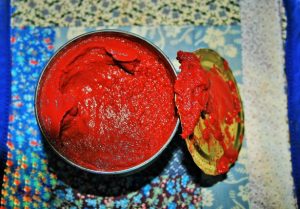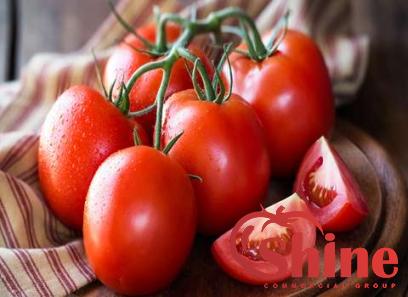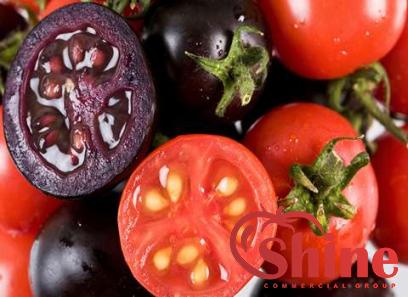Freezing the paste, particularly canned tomato pastes, enables you to keep it for an extended period of time. Because they do not include preservatives, domestic tomato pastes are more prone to deterioration and mold than industrial pastes. Furthermore, since every household creates the paste for at least a year, you must devise a method to keep it fresh for as long as possible.

To keep tomato paste, the freezer is the best option
Freezing homemade tomato paste is the best method to preserve it. Mold fungus will not develop on the paste after it has been frozen. Freezing the paste enables you to have a nutritious and tasty paste for a long period, without the flavor of the paste having altered. Of course, while freezing tomato paste, you need pay attention to minor and easy considerations that will be stated below.
When there were no freezers, when homemakers produced paste, they would pour the surplus into huge jars and completely close the lid to prevent air from entering. After that, the pots were excavated underground. What do you believe was the cause behind this? Yes, the bottom layers of the ground are colder, and this coolness made the paste more robust.
During the winter, when the air was chilly, the ground hole served as a freezer for the pastes within the jar. Therefore, the older ones also understood the secret of freezing the paste, only because of the possibilities they had, they accomplished it. The only method to preserve handmade pastes is to keep them cold. Even if homemade pastes are kept on the bottom levels of the refrigerator for an extended period of time, they may mold. As a result, freezing tomato paste seems to be the only method to keep it from deteriorating.
Pour as much paste as you need into suitable containers and store them on the higher levels of the refrigerator. Freeze any leftover paste as well. If you do not have a suitable container with no ventilation, it is advised that you freeze your homemade tomato paste. Don’t be concerned about freezing the paste. Because, interestingly, freezing the paste does not result in total freezing.
The paste’s freezing point is lower than the freezer temperature. As a result, even if the paste is frozen, it will not totally freeze and will not solidify. This implies that you may put the homemade paste in a small container and freeze it. Then take out as much paste as you need and put it back in the freezer. Please ensure that the frozen tomato paste is pliable enough to be readily removed. Unless the paste water content is high and the extra water freezes.

Freeze the created paste in different containers
One thing to bear in mind while freezing the paste is to use many containers. This implies that it’s best not to combine all of the pastes in one huge container. When you pour all of the paste into a container, it will be difficult to use. Because you have to take the can holding all of the pastes out of the freezer each time and take out the quantity you need.
This may expose the paste to too much air and cause it to mold. Furthermore, if you use a greasy or contaminated spoon to remove the paste, all of your pastes will be destroyed, and the outcome of your efforts will be lost. Divide the paste into many small containers to freeze.
- The ideal container for freezing paste is glass
It is preferable to freeze the paste in sturdy glass containers. Glass has the advantage of not reacting with its own interior substance. As a result, pastes stored in glass containers stay fresh for a long time and do not mold. Of course, while freezing tomato paste in a glass container, you should not fill it cap by cap. Because the freezing pressure may cause the glass to burst, use glass containers with plastic or stainless steel covers as well. Because metal doors may rust when exposed to dampness.
- Bottles of mineral water
One of the instruments you may use to freeze paste is mineral water bottles. Your preferences determine its size. However, it is preferable to use tiny bottles. Because you may take one of the bottles out of the freezer and place it in the refrigerator at any moment, you may discard the empty bottle after completing the paste.
These bottles are perfect for freezing the paste since they have sturdy lids and no air can permeate them. However, it has additional drawbacks, such as the generation of non-recyclable garbage. As a result, it is suggested that you only use the bottle when you have no other option.
- Freeze the paste in freezer bags
The freezer bag is the best option if you don’t have enough glass containers or prefer not to use a bottle of mineral water to freeze the paste. Pour the paste into little packets in the nylon freezer and place it in the freezer for this reason. In this scenario, having an appropriate container for the paste, pouring one box of paste into it, and consuming it each time is preferable.
When using freezer bags, make sure they are healthy. Because if one has a hole, the paste water will leak out and contaminate the whole freezer. Because, as previously said, the paste does not totally freeze in the freezer.

Canned tomato paste mold
When you open the canned tomato paste container’s lid, you’ll discover that white mold has formed on it. That is when your deliberation about whether or not to utilize paste starts. But what exactly should we do? Can moldy tomato paste be reused, or should it be discarded? Continue reading for a more accurate response. What should you do with rotten tomato paste? This is a question that you may have as well.
Unfortunately, tomato paste is a very delicate meal. Mold will grow fast if it is not kept at a low temperature, is not in an appropriate container, or is contaminated with a greasy and contaminated spoon. But the question is, what are we going to do with rotting tomato paste? Is mold hazardous, and can it cause disease? Sure, there is a solution to this problem.
When presented with moldy paste, some individuals remove the top and mold on it and ingest the paste, believing that the issue has been resolved. However, here is where the red siren will ring for you. Because this does not seem to be correct. When your tomato paste becomes moldy, the right and moral thing to do is to throw it away and not eat it at all.
Mold grows more easily in household pastes than in industrial pastes. Because they include no preservatives, it is not suggested to store handmade pastes in a single container and totally in the refrigerator, because if mold appears, you will have to discard the whole batch. As a result, you will sustain significant harm. It is preferable to preserve the paste in compact containers in the freezer and to place it in the refrigerator as required. If you’re not acquainted with freezing tomato paste, check out this post on how to freeze tomato paste.

- Why should we avoid consuming rotten tomato paste?
What is the solution to the problem of moldy tomato paste? Received. The best and most prudent course of action is to discard the paste and discontinue its use. However, why can’t you use rotting tomato paste? This relates to mould’ biological structure. Molds are deadly fungus that spread by spores.
When the paste molds, the molds generate a poison known as mycotoxin. Even if the moldy component and the bottom layer are removed, there is still a risk. Because the toxin may have also permeated the underlying layers. Furthermore, the mold-producing spores are minute and undetectable to the human eye. These spores may still be present in tomato paste.
So it seems that even removing the mold from the paste does not eliminate the poisons or spores that cause it. So, instead of putting your health or the health of your family members at danger, shake the rotten paste and toss it away.
Of course, no severe sickness has been documented as a result of rotten tomato paste. These molds have the potential to cause mild poisoning. However, mold allergies have resulted in death in several circumstances. These are very uncommon situations, and only a few individuals are allergic to moldy tomato paste, but common sense dictates that health should not be jeopardized because of some tomato paste.
Knowing what to do with rotting tomato paste is preferable than searching for it. Consider mold prevention. A few basic methods may easily keep the paste from getting stale and worthless. It is sufficient to choose an appropriate and compact container for hand-made paste. Please do not place the contaminated spoon in the paste container and store it on the top floors of the refrigerator, where the temperature is cooler, or freeze the paste.
Moldy tomato paste, as previously stated, should not be ingested in any form. Molds are toxic fungus that may harm human health. Mycotoxin is a toxin produced by these fungus. Even when the mold is removed, the toxin is still present in the paste. The paste also contains tiny fungus spores. Some individuals may be allergic to this poison or spore. So it is preferable to give it to his adversary and stop consuming it.

Canned tomato paste food coloring
One person wonders if the canned or glass tomato pastes contains food coloring. Another person wonders if the concentration is due to the pouring of an excess material. And a plethora of other issues. If we wish to classify meals based on the edges and stories around them, tomato paste is one of the highest classes. You may be wondering how. So there you have it. Rumor has it that this delectable sauce is far from factory-made. One person wonders if the tomato paste contains food coloring.
Another person wonders if the concentration is due to the pouring of an excess material. And a plethora of other issues. In this paragraph, we will address one of the many questions and myths surrounding tomato paste; Is there food coloring in tomato paste? Undoubtedly, knowing the proper answer to this issue can alleviate one of your concerns about eating or not consuming factory pastes, since many individuals are unable to manufacture homemade tomato paste and must rely on factory pastes.
- What is the source of tomato paste’s red color?
I’m not sure how many of you have seen ripe tomatoes. This tomato is completely green and flavorless. Surprisingly, this green fruit subsequently becomes totally red! Of course, if you know the structure and contents of tomatoes, you will not be astonished. Because lycopene is the chemical that gives tomatoes the red color. The green hue of tomatoes is caused by a chemical known as chlorophyll. Chlorophyll’s role is to absorb sunlight. As harvest season approaches, the days become shorter and the light shines brighter.

The chlorophyll duty stops here and dissolves in the tomatoes. Instead, it is replaced with a molecule known as lycopene. Lycopene, which gives tomatoes their red color, is naturally found in tomato paste. Naturally, lycopene is not a colorless material. It has distinct advantages. Lycopene contains antioxidant and anti-cancer effects, among other things. The most intriguing aspect is that after the process of boiling tomato paste is complete and the correct concentration is reached, lycopene reveals its color more clearly.
As a result, the first response to the issue concerning the color of tomato paste is that if the paste is sufficiently cooked and there is no extra water in it, it will have sufficient red color and no need for food coloring. If the tomato paste is soft and fluid and produces a decent color, it is likely to include color.
- Is food coloring used in industrial pastes?
In this part, we’ll look at whether tomato paste contains food coloring from a different angle. Let us respond. Of course, we are referring to industrial tomato pastes because handmade pastes do not contain food coloring unless otherwise specified. Of course, as previously said, the concentration and color of the paste might indicate whether or not it contains a food color.
Anyway, the topic of this section’s debate is industrial tomato paste. An industrial paste is made using indirect heat. This increases the color quality of industrial pastes by releasing more lycopene into the paste. Furthermore, the continual and appropriate heat helps the tomato paste to attain the optimum concentration and color.

- Do you, on the other hand, believe that food coloring is necessary?
To retain consumers, reputable manufacturers source tomatoes from reputed farmers and sort them before manufacturing tomato paste. They only use completely ripe tomatoes with brilliant red skin and meat. In such circumstances, the paste made from these tomatoes is unquestionably a natural and excellent hue, and no food coloring is required.
Fortunately, there are renowned manufacturers in the sector of tomato paste production in Iran nowadays, and all of them have passed their examinations. These firms manufacture industrial tomato paste that is made from first-rate tomatoes and has a proper concentration. So that the number of Brix or paste concentration in most of these products is between 26 and 30, which is a decent number, you should not opt for products that you do not know enough about at a low price.
They are based on what has been mentioned in response to the inquiry, “Does tomato paste include food coloring?” It is negative. Because industrial pastes are cooked in a consistent manner, they have a high concentration of lycopene. So, why are food colors necessary?
last words:
The buttom line is that no food coloring is present in industrial tomato paste, at least not in all respectable and well-known brands. These pastes are made using continuous and indirect heat, and a significant amount of lycopene is released in the tomato pastes. As a result, they are fully natural hues that may be used securely, independent of current rumors.










Your comment submitted.